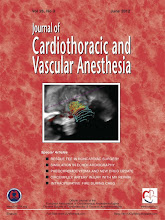
 Section Editor
Section EditorDalia A. Banks, MD
Section Editor
Department of Anesthesia, Critical Care and Pain Medicine Beth Israel Deaconess Medical Center, Harvard Medical School, Boston, MA
Address Reprint Requests to Haider Javed Warraich, MD, Cardiovascular Anesthesia Research Fellow, CC 454, 1 Deaconess Road, Beth Israel Deaconess Medical Center, Boston MA 02215. E-mail: hwarraiac@bidmc.harvard.edu
Key words: aortic valve replacement, mitral regurgitation, aortic stenosis
A 75-YEAR-OLD MAN with dizziness and shortness of breath underwent a balloon valvuloplasty performed for critical aortic stenosis. After experiencing minimal symptomatic relief, the patient presented to the authors' tertiary care center with worsening symptoms 2 weeks after the procedure. The patient's history was significant for congestive heart failure, type-2 diabetes mellitus, coronary artery disease, chronic atrial fibrillation, and hypertension, and he had undergone a coronary artery bypass graft procedure in 1992. Because of a lack of symptomatic improvement after balloon valvuloplasty and persistence of decompensated congestive heart failure, despite his high risk, it was decided to perform aortic valve replacement (AVR).
After an uneventful induction of general anesthesia, a pre-cardiopulmonary bypass (CPB) transesophageal echocardiographic (TEE) examination was performed; an AV area of 0.5 cm2(critical <0.8 cm2) was calculated with the continuity equation with a peak transaortic valvular gradient of 54 mmHg (normal <20 mmHg) with a mean gradient of 38 mmHg (moderate 25-40 mmHg) and mild aortic insufficiency. The left ventricular (LV) ejection fraction was 45% to 50%, and the LV end-diastolic diameter was 6.1 cm with normal LV wall thickness. Right ventricular function was normal with no hypertrophy.
Fig 1 The prebypass TEE examination from the midesophageal 4-chamber view shows severe MR. (Inset) Midesophageal long-axis view.
Echocardiographic Findings
TEE interrogation of the mitral valve (MV) revealed moderate-to-severe (3+) mitral regurgitation (MR) (Fig 1andVideo 1[supplementary videos are available online]), with vena contracta of 6 mm (severe >=5.5mm) and mildly thickened leaflets; there was no structural abnormality of the MV. The echocardiographic challenge was to rule in or out the presence of any organic/structural cause of MR. A 3-dimensional en face view of the MV from the left atrial perspective revealed failure of coaptation between the A3 and P3 segments of the mitral leaflets (Video 2). There was no evidence of any structural abnormality. The left atrium was dilated with a long-axis dimension of 6.4 cm (normal <4.0 cm). A discussion was initiated with the surgeons regarding different therapeutic options, which included double valve replacement, AVR with MV repair, and AVR alone.
Clinical Challenge
The clinical challenge was to weigh the increased risk of concomitant MV surgery during AVR and to accurately predict the effect of AVR on the severity of MR.
Surgical Decision
After weighing the pros and cons, it was decided to perform AVR alone. A 21-mm Edwards pericardial tissue valve was used. After successful valve replacement and separation from CPB, post-CPB transesophageal echocardiography showed a well-seated bioprosthetic AV. The AV area was noted to be 1.5 cm2with trace central regurgitation and no paravalvular leak. The LV ejection fraction improved to 50-55%, and MR improved to moderate (2+) (Fig 2 and Video 3). A follow-up transthoracic echocardiogram 2 months after surgery revealed MR to still be moderate (2+).
Fig 2 The postbypass TEE examination shows improvement of the MR grade to moderate severity.




